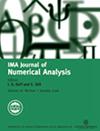Perturbation estimates for order-one strong approximations of SDEs without globally monotone coefficients
IF 2.4
2区 数学
Q1 MATHEMATICS, APPLIED
引用次数: 0
Abstract
To obtain strong convergence rates of numerical schemes, an overwhelming majority of existing works impose a global monotonicity condition on coefficients of stochastic differential equations (SDEs). Nevertheless, there are still many SDEs from applications that do not have globally monotone coefficients. As a recent breakthrough, the authors of (Hutzenthaler and Jentzen 2020, Ann. Prob., 48, 53–93) originally presented a perturbation theory for SDEs, which is crucial to recovering strong convergence rates of numerical schemes in a non-globally monotone setting. However, only a convergence rate of order $1/2$ was obtained there for time-stepping schemes such as a stopped increment-tamed Euler–Maruyama (SITEM) method. An interesting question arises, also raised by the aforementioned work, as to whether a higher convergence rate than $1/2$ can be obtained when higher order schemes are used. The present work attempts to give a positive answer to this question. To this end, we develop some new perturbation estimates that are able to reveal the order-one strong convergence of numerical methods. As the first application of the newly developed estimates, we identify the expected order-one pathwise uniformly strong convergence of the SITEM method for additive noise driven SDEs and multiplicative noise driven second-order SDEs with non-globally monotone coefficients. As the other application, we propose and analyze a positivity preserving explicit Milstein-type method for Lotka–Volterra competition model driven by multi-dimensional noise, with a pathwise uniformly strong convergence rate of order one recovered under mild assumptions. These obtained results are completely new and significantly improve the existing theory. Numerical experiments are also provided to confirm the theoretical findings.无全局单调系数的SDEs的一阶强近似的微扰估计
为了获得数值格式的强收敛率,绝大多数现有研究都对随机微分方程的系数施加了全局单调性条件。然而,仍然有许多来自应用程序的sde不具有全局单调系数。作为最近的一项突破,Hutzenthaler和Jentzen 2020的作者,Ann。概率。在非全局单调条件下恢复数值格式的强收敛率是至关重要的。然而,对于时间步进方案,如停止增量-收敛Euler-Maruyama (SITEM)方法,只得到$1/2$阶的收敛速率。上述工作也提出了一个有趣的问题,即当使用高阶格式时,是否可以获得比$1/2$更高的收敛率。本文试图对这个问题给出一个肯定的答案。为此,我们提出了一些新的摄动估计,这些估计能够揭示数值方法的一阶强收敛性。作为新开发估计的第一个应用,我们确定了具有非全局单调系数的加性噪声驱动SDEs和乘性噪声驱动二阶SDEs的SITEM方法的期望阶一路径一致强收敛性。作为另一个应用,我们提出并分析了Lotka-Volterra竞争模型在多维噪声驱动下的正保持显式milstein型方法,该方法在温和假设下具有一阶的路径一致强收敛率。这些结果是全新的,对现有理论有了很大的改进。数值实验也证实了理论结果。
本文章由计算机程序翻译,如有差异,请以英文原文为准。
求助全文
约1分钟内获得全文
求助全文
来源期刊
CiteScore
5.30
自引率
4.80%
发文量
79
审稿时长
6-12 weeks
期刊介绍:
The IMA Journal of Numerical Analysis (IMAJNA) publishes original contributions to all fields of numerical analysis; articles will be accepted which treat the theory, development or use of practical algorithms and interactions between these aspects. Occasional survey articles are also published.

 求助内容:
求助内容: 应助结果提醒方式:
应助结果提醒方式:


